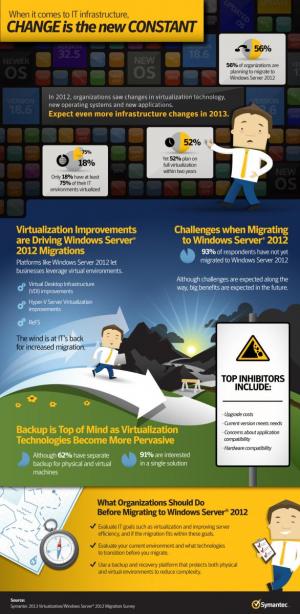- VOX
- Technical Blogs
- Enterprise Data Services Community Blog
- Symantec’s Windows Server 2012 Migration/Virtualiz...
Symantec’s Windows Server 2012 Migration/Virtualization Survey
- Subscribe to RSS Feed
- Mark as New
- Mark as Read
- Bookmark
- Subscribe
- Printer Friendly Page
- Report Inappropriate Content
 Nobody can deny that the data center today is undergoing a dramatic transformation, bringing in all sorts of new technology, and constantly in a state of change. Between new devices, operating systems and service delivery platforms, change is really the only thing IT can depend on.
Nobody can deny that the data center today is undergoing a dramatic transformation, bringing in all sorts of new technology, and constantly in a state of change. Between new devices, operating systems and service delivery platforms, change is really the only thing IT can depend on.
We set out to see how businesses are doing when it comes to navigating their way through these changes. Our recent Windows Server 2012 Migration/Virtualization Survey was created to take a closer look at organizations attitudes towards migration, what their adoption plans are and get a closer look at virtualization trends in the market.
Change is the New Constant
The first finding that really jumped out at us is the fact that IT is in a constant state of change. We found specifically that organizations anticipant significant change when it comes to virtualization. If fact, while just 18 percent of the businesses we surveyed have virtualized at least three-quarters of their IT environments today, just over half of them (52 percent) will take the plunge into full virtualization within the next two years.
Windows Server 2012 Adoption Is Happening Gradually
Next, we found that while many are planning to upgrade to Windows Server 2012, 93 percent haven’t actually made the move yet. For those that are planning to migrate:
- 13 percent plan to make the move after the 1st service pack
- 15 percent within the next 6 months
- 17 percent within the next 12 months
- 11 percent in more than 12 months
One significant factor that is keeping people from making the transition is the cost of the upgrade, and some businesses are slow to make the change because their current version is getting the job done. And with IT complexity increasing, there are also concerns about compatibility issues with current hardware or software.
On the flip side our survey revealed that the most important reasons companies are making the switch to Windows Server 2012 include improvements in the virtual desktop infrastructure, Hyper-V server virtualization and a more resilient file system called ReFS that improves scalability and resource management.
Data Protection is Top of Mind
With all the change, the one thing that needs to remain constant is an organization’s ability to ensure their data is protected no matter where it resides. We found that although nearly two-thirds (62 percent) of companies use multiple solutions to protect their physical and virtual systems, nine in ten are interested in single solution and what it can offer. This is especially important for SMBs, who have fewer resources to dedicate to data and system protection.
Making the Transition Successfully
While many businesses are eager to begin enjoying the benefits of Windows Server 2012, planning for an effective transition is important to get the most out of the investment. We recommend following these guidelines before making the switch:
- Consider how IT affects your business goals overall and how your company operations will benefit in making the transition. If you clearly look at what you want to accomplish, whether that be improved agility for business decisions or boosting the efficiency of servers, knowing where you want to be can illuminate the path to get there and help decide what part the upgrade will play.
- You will also need to evaluate where your company is right now. This includes current applications and servers, and where they are located. In some cases it may be helpful to transition physical servers to virtual machines before adopting the new version of Windows Server 2012, such as companies that have servers in multiple locations.
- It’s important to maintain current levels of service while making the transition. To ensure that you don’t lose applications or information, confirm that you have a backup and recovery platform deployed that can recover needed resources in case of complications. You can also minimize complexity and reduce costs by choosing a single backup and recovery solution that covers your physical and virtual resources.
For more information on Symantec’s Windows Server 2012 Migration/Virtualization Survey, we invite you to read these additional resources:
- Symantec’s Windows Server 2012 Migration/Virtualization Survey Report
- Symantec’s Windows Server 2012 Migration/Virtualization Survey Infographic
- Symantec’s Windows Server 2012 Migration/Virtualization Survey SlideShare Presentation
You must be a registered user to add a comment. If you've already registered, sign in. Otherwise, register and sign in.
- Trust your Backup Image with Backup Exec Malware Scan in Backup Exec
- Join the Backup Exec Beta Program in Backup Exec
- Backup Exec is an Easy Install, 4 Things you Ought to Know in Backup Exec
- Reinventing NetBackup Operations with NetBackup IT Analytics in Protection
- Meet the Hiring Manager: Sachin Naik in Inside Veritas

